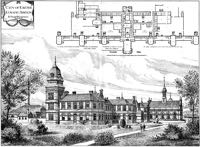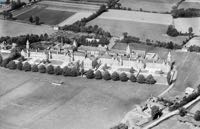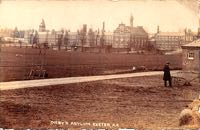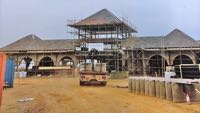
The Exeter City Asylum – also known as Digby Hospital
Page updated 12th February 2019
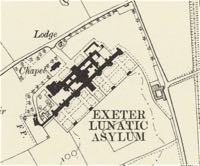 In
the 19th Century, the care of those who were mentally unfit to lead an
independent life, was given in what was thought to be a more humane and
scientific way. In 1801, the St Thomas Lunatic Asylum was opened at the
bottom of Dunsford Road, while the Exe Vale Hospital at Wonford House,
a private asylum for the rich, was opened in 1869. In the early 1880s,
Exeter decided to build its own municipal “lunatic asylum”, as it was
termed, to treat and care for those with mental ill health.
In
the 19th Century, the care of those who were mentally unfit to lead an
independent life, was given in what was thought to be a more humane and
scientific way. In 1801, the St Thomas Lunatic Asylum was opened at the
bottom of Dunsford Road, while the Exe Vale Hospital at Wonford House,
a private asylum for the rich, was opened in 1869. In the early 1880s,
Exeter decided to build its own municipal “lunatic asylum”, as it was
termed, to treat and care for those with mental ill health.
The site chosen for the new asylum was about 200 metres from the Exeter to Topsham railway line on land that was part of Digby Farm. After a competition by the Exeter Corporation, the chosen design was chosen from a short list of eight. The design of the Exeter born architect Robert Stark Wilkinson FRIBA, who had previously designed the Doulton & Co., pottery works at Lambeth, London was chosen. He adopted a Queen Anne style with the liberal use of ceramic decoration, half from the Great Western Pottery, Chudleigh, and half from Doulton of Lambeth. Although originally estimated to cost £20,000 by the Corporation, the eventual cost was almost £100,000, of which the building was £56,000.
The building, of some 237 meters (777 ft) in length, was split into the more utilitarian north-western range containing the service, administration, and laundry rooms, along with accommodation for the laundry workers. The south-eastern range was a series of male and female ‘inmates’ areas separated by a recreation hall. In the centre of the range was a grand entrance into the main hall, as befits such a building. At one end of each range was a large tower, of differing design. There was also a farm for the asylum, to the south-east of the main block, which provided work for the male patients.
Tenders were advertised in November 1883, and the chosen contractor was Mr Henry Phillips. The Corporation had already negotiated with the railway to open a siding on the Exmouth railway line for carry construction materials to the building site. Although a 50 ft well was sunk, especially for the Asylum in 1885, concern was raised as to whether it would provide sufficient water for 400 people. In the few months before it opened, consideration was given to running a pipe from Wonford House to Digby to supply city water. In the event, improvements were made, including a filter.
Opening
The Exeter City Asylum was opened on 29 September 1886. Within days, the hospital was occupied, by patients who were brought in from the privately run Fisherton House Asylum, Salisbury, because the city did not have adequate facilities their own. When first opened, the newspapers often referred to the institution as the non PC ‘Lunaville’, although it soon became the City Asylum and by the locals, ‘Digbys’.
By 1897 the Asylum held 342 patients, 158 male and 188 female. The dining halls were converted into dormitories for an additional 40 patients, while in 1907 new and more modern machinery introduced in the laundry.
All early as 1914, Digby Asylum was included in the list of Devon hospitals to be requisitioned as a war hospital. Rather than transfer it to the military, the hospital remained open taking in patients from the Bristol City Asylum, Fishponds, when it became the Beaufort War Hospital. In May 1918, plans were put in place to use it for up to 800 wounded. There was considerable discussion about the proposal, but it did not go further, probably because the need diminished due to the signing of the Armistice in November 1918.
The Asylum strike
A strike broke out on 30 April 1919, when a carpenter named Glanville, who had worked at Digby for thirty years, was given notice in December 1918. As President of the National Asylum Workers Union, Glanville had requested that the Council should pay the asylum artisans the Trade Union rate. The reply was “You are not worth the trade union rate”, and he was charged with insolence. After he said to the Medical Superintendent “Well, sir, I do not consider that you are in a position to judge whether I am in a position to judge whether you are worth what you're being paid.” Three days later when he went for his pay he was told “There is one week’s pay due to you, and there is one week in lieu of notice. Leave here, and do not come back again." Mr Glanville replied, ”I will take the week that is due to me, but the other week I will leave with you, and I will report the case to my union.” The strike was called. At the end of June, some nurses had also walked out, and arbitration was refused by the union. At the beginning of August, there was a call for other Exeter Trade Unions to strike in sympathy, but the ballot was two to one against. By December, the Council had increased the wages of the workers, but had not taken back any of the strikers.
In 1920 it was decided to increase the charge for keeping a patient from 24 to 26 shillings per week. The same report had the unfortunate comment at the end "A Member: It is a pity these unfortunates cannot be got rid of: smothered or something–(laughter)."
The hospital would provide entertainment at Christmas for the patients, and in December 1926, at a cost of £246, a cinematograph projector was purchased. This was probably used for training films for the staff, as well as entertainment for the patients.
Self sufficient in war
Just when the country was requiring more food production in 1940, the City Mental Hospital, as it was then named, had a herd of 100 pigs on the farm. It also had a prodigious crop of potatoes, and was self sufficient in oats and barley as animal feed.
Digby Hospital was absorbed into the National Health Service when it was founded in July 1948. It became part of the Devon Mental Hospital Group, and eventually it became the Exe Vale Hospital with Exminster and Wonford House.
One hundred and one years after it opened, Digby was closed in 1987. The land attached to the hospital was divided into a section for residential housing, and the rest for a retail park that would include a large Tesco and PC World, among others. The building, which was Listed Grade II was converted into residential use, preserving the outer facade as much as possible.
Sources: Website asylumprojects.org, the British Library Newspaper Archives, Kellys Directory 1897, Historic England Archives. countyasylums.co.uk
│ Top of Page │
